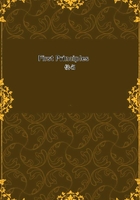
第139章
In the centre of this there at length comes the primitive streak or trace,which, as its name implies, is indefinite but by-and-by "becomes a morepronounced structure." Within this streak or trace the vertebrate axisfirst shows itself. Beginning as a shallow groove, it becomes slowly morepronounced; its sides grow higher; their summits overlap and at last unite;and so the indefinite groove passes into a definite tube, forming the vertebralcanal. In this vertebral canal the leading divisions of the brain are atfirst discernible only as slight bulgings; while the proto-vertebrae commenceas indistinct modifications of the tissue bounding the canal. Meanwhile inkindred ways the indefinite out-spread membrane through which are absorbedthe materials for the unfolding structures around, is changed, into a definitealimentary canal. And in an analogous manner the entire embryo, which atfirst lies outspread on the yelk-sack, gradually rises up from it, and bythe infolding of its ventral region becomes a separate mass, definitely outlined,connected with the yelk-sack only by a narrow duct.
These changes through which the general structure is marked out with slowly-increasingprecision, are paralleled in the evolution of each organ. The liver commencesby multiplication of certain cells in the wall of the intestine. The thickeningproduced by this multiplication, "increases so as to form a projectionupon the exterior of the canal -- a hollow bud;" and at the same timethat the organ grows and becomes distinct from the intestine, the channelsrunning through it are transformed into ducts having clearly-marked walls.
Similarly, certain cells of the external coat of the alimentary canal atits upper portion, accumulate into lumps or buds from which the lungs aredeveloped; and these, in their general outlines and detailed structure, acquiredistinctness step by step. But even were no examples given, it would be undeniablethat since a simple cluster of similar cells grows into head, trunk, andlimbs of distinct shapes, each made up of many organs containing parts severallyhaving clear outlines and composed of specific tissues, increase of definitenesshas been a leading trait of the transformation.
Changes of this order continue long after birth; and, in the human being,are some of them not completed till middle life. During youth, most of thearticular surfaces of the bones remain rough and fissured -- the calcareousdeposit ending irregularly in the surrounding cartilage. But between pubertyand the age of thirty, these articular surfaces are finished off into smooth,hard, sharply-cut "epiphyses." Generally, indeed, we may say thatincrease of definiteness continues when there has ceased to be any appreciableincrease of heterogeneity. And there is reason to think that those modificationswhich take place after maturity bringing about old age and death, are modificationsof this nature; since they cause rigidity of structure, a consequent restrictionof movement and of functional pliability, a gradual narrowing of the limitswithin which the vital processes go on, ending in an organic adjustment tooprecise -- too narrow in its margin of possible variation to permit the requisiteadaptation to changes of external conditions. §133. To give clear proof that the Earth's Flora and Fauna, regardedeither as wholes or in their separate species, have progressed in definiteness,is no more possible than it was to prove that they have progressed in heterogeneity: the facts are not sufficient. If, however, we allow ourselves to reason fromthe hypothesis, now daily rendered more probable, that every species hasarisen through the accumulation of modifications upon modifications, justas every individual arises. we shall see that there must have been a progress,from the indeterminate to the determinate, both in the particular forms andin the groups of forms.
We may set out with the significant fact that the lowest organisms (whichare analogous in structure to the germs of all higher ones) have so littledefiniteness that it is difficult, if not impossible, to decide whether theyare plants or animals. Respecting sundry of them there are unsettled disputesbetween zoologists and botanists. Note next that among the Protozoa, greatindefiniteness of shape is general. Of sundry shell-less Rhizopods the formis so irregular as to admit of no description: it is neither alike in anytwo individuals nor in the same individual at successive moments. By aggregationof Protozoa, are produced, among other creatures, the Sponges, most of whichare indefinite in size, in contour, in internal arrangement; and such moredefinite aggregates as the Hydra are made indefinite both by the great differencesbetween their contracted and expanded states and by their reproductive developments.
As further showing how relatively indeterminate are the simplest organisms,it may be mentioned that their structures vary greatly with surrounding conditions: so much so that, among the Protozoa and Protophyta, many forms which wereonce classed as distinct species, and even as distinct genera, are foundto be merely varieties of one species. If, now, we call to mind how precisein their traits are the highest organisms -- how sharply cut their outlines,how invariable their proportions, and how comparatively constant their structuresunder changed conditions; we cannot deny that greater definiteness is oneof their characteristics. If they have been evolved out of lower organisms,increase of definiteness has been an accompaniment of their evolution.